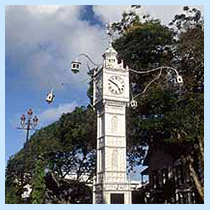 |
 |
|
GEOGRAPHY & HISTORY
|
| GEOGRAPHY |
|
|
The Republic of Seychelles comprises 115 islands occupying a land area of 455 km² and an Exclusive Economic Zone of 1.4 million km² in the western Indian Ocean. It represents an archipelago of legendary beauty that extends from between 4 and 10 degrees south of the equator and which lies between 480km and 1,600km from the east coast of Africa. Of these 115 islands, 41 constitute the oldest mid-oceanic granite islands on earth while a further 74 form the low-lying coral atolls and reef islands of the Outer Islands. The granitic islands of the Seychelles archipelago cluster around the main island of Mahé, home to the international airport and the capital, Victoria, and its satellites Praslin and La Digue. Together, these Inner Islands form the cultural and economic hub of the nation and contain the majority of Seychelles’ tourism facilities as well as its most stunning beaches. A sparkling collection of low lying, coral isles, sand cays and atolls make up 5 separate groups of Outer Islands which include one of two of Seychelles' UNESCO World Heritage Sites, amazing 'Aldabra', the largest raised coral atoll on earth. The other, the fabulous Vallée de Mai where the extraordinary Coco-de-mer nut grows on ancient palms, once earned Seychelles the reputation for being the original site of the biblical Garden of Eden.
|
|
| CLIMATE |
|
|
Seychelles’ enviable climate is always warm and without extremes. In this tropical haven the temperature seldom drops below 24°C or rises above 32°C. All but the remotest southern islands lie comfortably outside the cyclone belt and the average daily period of sunshine is in excess of 7 hours making Seychelles’ a year round destination for sun worshippers and beach lovers. The climate is healthy and many tropical diseases such as malaria and yellow fever are unknown. Vaccinations are unnecessary. It is generally cooler when the north-west trade winds blow during the months of November to March. The sea is generally calm and the weather warm and humid, with average winds of 15 - 22 kilometers per hour. A larger amount of the annual rainfall falls during the months of December to February compared to other months. The average number of rainy (days with 1 millimeter or more rainfall) in December, January and February are 18, 17 and 11 days respectively. It is also fairly cloudy at times during those months and therefore less sunshine. The weather is hottest from December to April, and the humidity is high - often 80% or higher. The months of May to October bring drier, cooler weather, and livelier seas - particularly on south-eastern coasts – and winds of 19 -37 kilometers per hour are common.
|
| TIME |
|

|
Seychelles Standard Time is 4 hours ahead of Greenwich Mean Time (GMT+4). Seychelles does not operate Daylight-Saving Time. |
| HISTORY |
|
|
Seychelles is a comparatively young nation which can trace its first settlement back to 1770 when the islands were first settled by the French, leading a small party of whites, Indians and Africans. The islands remained in French hands until the defeat of Napoleon at Waterloo, evolving from humble beginnings to attain a population of 3,500 by the time Seychelles was ceded to Britain under the treaty of Paris in 1814. During this period Seychelles came to know the enlightened policies of administrators such as Pierre Poivre, the brilliant politicking of Governor Queau de Quinssy and, of course, the terrible repercussions of the French Revolution. Under the British, Seychelles achieved a population of some 7,000 by the year 1825. Important estates were established during this time producing coconut, food crops, cotton and sugar cane. During this period Seychelles also saw the establishment of Victoria as her capital, the exile of numerous and colourful troublemakers from the Empire, the devastation caused by the famous Avalanche of 1862 and the economic repercussions of the abolition of slavery. Seychelles achieved independence from Britain in 1976 and became a republic within the commonwealth. Following a period of single party rule by the government of Mr. France Albert René, on December 4, 1991, President René announced a return to the multiparty system of government, 1993 saw the first multiparty presidential and legislative elections held under a new constitution in which President René was victorious. President René also won the 1998 and 2003 elections before transferring the Presidency to James Alix Michel in June 2004. |
Photo copyrights: STB Team, Leisure and Business 2012 - SEYCHELLES, other copyright 2013 Honorary Consulate of the Republic of Seychelles in Hong Kong. All Rights Reserved. |


